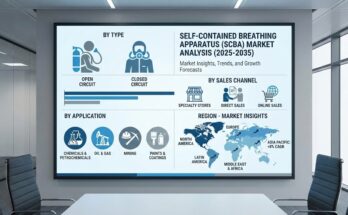The aerial robot market in the United States is entering a decade of transformational expansion as industries rapidly shift toward automation, real-time data acquisition, and unmanned operational efficiency. According to a new analysis by Fact.MR, the U.S. aerial robot market is projected to surge from USD 3.8 billion in 2025 to USD 15.0 billion by 2035, recording an absolute increase of USD 11.2 billion. This reflects a total growth of 295% and a robust CAGR of 14.8% over the forecast period.
As organizations across defense, agriculture, logistics, construction, emergency response, and energy sectors embrace autonomous systems, aerial robots are becoming indispensable tools for surveillance, inspection, mapping, transport, and environmental monitoring.
Strategic Market Drivers
Automation Becomes a Cornerstone of U.S. Industries
The shift toward autonomous and semi-autonomous operations is accelerating nationwide. Industries are leveraging aerial robots for real-time insights, operational safety, and labor optimization. From infrastructure inspection to crop monitoring, the adoption of drones and UAV-based systems continues to widen across commercial, industrial, and government applications.
Advancements in onboard computing, AI-driven navigation, and energy-efficient propulsion systems are enabling high-precision, long-endurance aerial robots suited for mission-critical tasks.
Browse Full Report: https://www.factmr.com/report/aerial-robot-market-analysis-in-the-usa
Defense Modernization and National Security Investments
The U.S. Department of Defense remains one of the largest adopters of aerial robotic technologies. Rising geopolitical complexities and the need for intelligence, surveillance, target acquisition, and reconnaissance (ISTAR) are driving large-scale procurement. Autonomous swarm capabilities, stealth drones, and tactical UAVs are shaping next-generation defense operations.
Increased investment in unmanned aerial systems (UAS) programs and cybersecurity-enhanced drone platforms further strengthens market demand.
Industrial Digitization & Smart Infrastructure Fuel Adoption
The USA’s rapid push toward Industry 4.0 is boosting the utilization of aerial robots in manufacturing, energy grid monitoring, mining, utilities, and smart city development. Aerial robots support predictive maintenance, asset inspection, environmental compliance, and digital twin creation—significantly reducing operational risks and costs.
Integrations with IoT, cloud mapping platforms, and sensor technologies are unlocking high-value data ecosystems for real-time decision-making.
E-commerce & Logistics Drive New Use Cases
With the rise of same-day delivery models, aerial robots are gaining traction for last-mile delivery, warehouse inventory assessments, and automated transportation networks. Pilot programs by leading logistics firms are accelerating commercialization of aerial delivery vehicles and autonomous fleet management platforms.
Regional Growth Highlights
United States: The Global Pioneer in Aerial Robotics
The USA leads worldwide innovation in aerial robot development, supported by advanced R&D ecosystems, strong venture capital inflows, and high adoption across both public and private sectors. States such as California, Texas, Florida, Virginia, and Washington are emerging as major hubs for drone manufacturing, testing, and deployment.
Market Segmentation Insights
By Robot Type
- Quadcopters & Multirotors – Dominant due to maneuverability and ease of use
- Fixed-Wing Aerial Robots – Preferred for long-range and endurance missions
- Hybrid VTOL Systems – Fastest-growing segment for mixed operational needs
By Application
- Defense & Security – Largest segment, driven by surveillance and tactical deployment
- Infrastructure & Construction – Strong growth through asset inspection and mapping
- Agriculture & Environmental Monitoring – Rapid adoption for smart farming
- Logistics & Delivery – Emerging high-potential category
- Emergency Response & Disaster Management – Critical for search, rescue, and fire monitoring
By End-Use Sector
- Government & Defense
- Energy & Utilities
- Agriculture
- Transportation & Logistics
- Manufacturing
- Mining & Oil & Gas
Challenges Impacting Market Growth
- Stringent FAA Regulations – Airspace limitations and compliance complexities
- Cybersecurity Risks – Vulnerability to hacking and data breaches
- High Initial Investment – Advanced systems require substantial upfront costs
- Skilled Workforce Gaps – Need for trained pilots, data analysts, and maintenance professionals
Competitive Landscape
The U.S. aerial robot market is moderately competitive, with a mix of global tech leaders, defense contractors, drone manufacturers, and AI-driven robotic startups. Companies are focusing on autonomous navigation, payload enhancement, endurance improvement, and AI-integrated data analytics.
Key Companies Profiled
- Skydio
- DJI (commercial presence in USA)
- AeroVironment
- Northrop Grumman
- Lockheed Martin
- Parrot SA
- Teledyne FLIR
- Kespry
- Zipline
- Amazon Prime Air
Manufacturers are prioritizing advanced sensors, long-duration batteries, anti-collision systems, and secure communications networks to support mission-critical operations.
Recent Developments
- 2024: Major U.S. defense tech firms announced next-generation autonomous swarm drone platforms with enhanced battlefield intelligence capabilities.
- 2023: Commercial drone manufacturers launched AI-powered inspection robots for utilities and energy companies.
- 2022: Logistics firms expanded pilot programs for autonomous aerial delivery in urban and suburban regions.
Future Outlook: A Decade of Autonomous Air Mobility
Over the next decade, the aerial robot market in the USA will be shaped by technological breakthroughs in AI navigation, lightweight materials, extended flight endurance, and autonomous fleet management. Increasing adoption across energy, defense, logistics, and smart infrastructure will continue to push the market toward rapid scale.
As industries shift toward sustainable automation and data-centric operations, aerial robots will play a pivotal role in transforming national security, industrial workflows, environmental monitoring, and mobility solutions. The U.S. market is primed for exceptional growth, driven by innovation, regulatory advancements, and expanding commercial applications.



